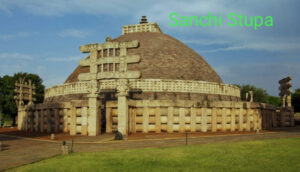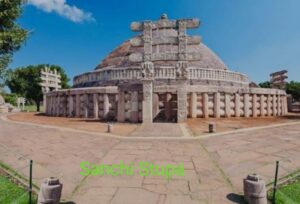Sanchi Stupa, a testament to the glory of ancient Buddhist architecture, stands majestically in the state of Madhya Pradesh, India. Renowned for its spiritual and historical significance, this monument is a UNESCO World Heritage Site, attracting scholars, historians, and tourists from around the globe. The Sanchi Stupa is not merely a relic of the past but a living symbol of Buddhist heritage and art.

1. Sanchi Stupa: Historical Background
The origins of the Sanchi Stupa can be traced back to the 3rd century BCE, during the reign of Emperor Ashoka, one of India’s most illustrious rulers. Ashoka, after embracing Buddhism, commissioned the construction of the Stupa to enshrine the relics of Lord Buddha and to propagate the teachings of Buddhism. This period marked the beginning of Sanchi’s prominence as a center of Buddhist activity.
Over the centuries, the Sanchi Stupa underwent several expansions and renovations under the patronage of different rulers, particularly during the Shunga and Satavahana periods. Each phase of construction added new elements to the Stupa, enhancing its grandeur and architectural complexity.
2. Sanchi Stupa: Architectural Features
The architectural brilliance of Sanchi Stupa lies in its simplicity and symbolic design. The primary structure, known as the Great Stupa or Stupa No. 1, is a massive hemispherical dome built over a central chamber housing the relics of Buddha. This dome, or Anda, symbolizes the universe, encapsulating the Buddhist cosmology.
Encircling the dome is a railing, or Vedika, which separates the sacred space from the mundane world. The four cardinal points are marked by elaborately carved gateways, known as Tirana’s , which are masterpieces of ancient Indian art. These Tirana’s are adorned with intricate carvings depicting various events from the life of Buddha and the Jataka tales, which are stories of Buddha’s previous lives.
The Har mika, a square railing on top of the dome, represents the world mountain, Meru, and the Chhatra, a triple umbrella structure above the Har mika, symbolizes the three jewels of Buddhism: Buddha, Dharma (law), and Sangha (community).

3.Sanchi Stupa: Artistic and Cultural Significance
The Tirana’s of Sanchi Stupa are particularly noteworthy for their exquisite carvings and intricate designs. These gateways narrate the story of Buddha’s life and his path to enlightenment through vivid and detailed sculptures. The depictions of the Jataka tales on the Tirana’s serve as moral and spiritual lessons, illustrating the virtues of compassion, self-sacrifice, and moral integrity.
The artistic style of Sanchi reflects a blend of indigenous Indian art with influences from Persian and Greek traditions, showcasing the cultural syncretism of the period. The carvings are not only of religious significance but also provide insights into the social and cultural life of ancient India.
4. Preservation and Restoration
The Sanchi Stupa has withstood the ravages of time, owing to the efforts of various preservationists and archaeologists. In the 19th century, the British archaeologist Sir Alexander Cunningham undertook significant restoration work to protect and preserve the site. The Archaeological Survey of India (ASI) continues to play a crucial role in the conservation of this ancient monument.
Despite these efforts, the Sanchi Stupa faces challenges such as weathering, pollution, and the impact of tourism. Continuous maintenance and conservation strategies are essential to safeguard this heritage site for future generations.
5. Visiting Sanchi Stupa
Sanchi Stupa is easily accessible, with the nearest airport located in Bhopal, approximately 46 kilometers away. Bhopal is also well-connected by rail and road, making it a convenient starting point for visitors. The best time to visit Sanchi is between October and March when the weather is pleasant.
Visitors to Sanchi Stupa can explore the Great Stupa, along with several smaller stupas and monasteries within the complex. The Sanchi Museum, located nearby, houses numerous artifacts and provides a deeper understanding of the site’s historical and cultural context. Additionally, the serene and well-maintained surroundings of Sanchi offer a tranquil retreat for those seeking spiritual solace.
Conclusion:
Sanchi Stupa stands as a monumental tribute to the architectural and artistic genius of ancient India. Its historical significance and cultural richness make it a vital part of the Buddhist heritage. As a symbol of peace, enlightenment, and artistic excellence, the Sanchi Stupa continues to inspire and captivate all who visit.
The enduring legacy of Sanchi Stupa lies not only in its stone and mortar but in the timeless teachings of Buddha that it enshrines. As we delve into the history and beauty of this ancient marvel, we gain a deeper appreciation for the spiritual and cultural heritage it represents.
FAQ:
1.What is Sanchi Stupa famous for?
2.Who built Sanchi Stupa in Madhya Pradesh?
3.Which river is Sanchi Stupa in?
4.What are the 10 lines on Sanchi Stupa in English?
5.Sanchi Stupa constructed by
6.Sanchi Stupa is located in which district
7.10 lines on Sanchi Stupa
8.Sanchi Stupa timings
9.Sanchi Stupa images
10.Sanchi Stupa architecture

